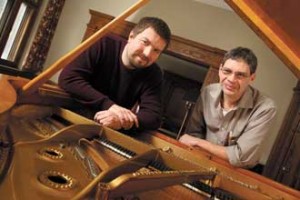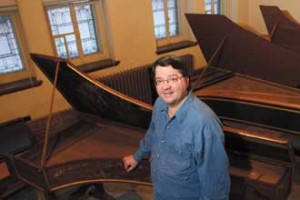
Schulich’s piano tuners have musicians hitting all the right notes
By Chris Chipello
There are upwards of 125 pianos at McGill’s Schulich School of Music and no one knows them better than Kerry Wagner. For the past 25 years, he has been poking, prodding and teasing the instruments into tune.
Wagner learned the craft from his father, Lloyd, who also tended to McGill’s pianos until he retired in 1995.
Along with the two other piano tuners on Schulich’s staff, Kerry Wagner keeps the instruments fit – no easy task, given the heavy use they get at one of Canada’s biggest music schools.
The technicians typically start their workday around 7 a.m., so they can sound out temperamental keyboards during the still hours before Schulich’s hundreds of students filter into classrooms and practice studios.
The tuning of a piano starts with the middle octave in the keyboard. The tuner then works his way up to the high notes and down to the bass end, adjusting steel strings inside the piano with a wrench-like instrument known as a tuning hammer. Computerized gadgets enable the technicians to check the precise frequency of notes (the A above middle C is the traditional tuning note, at 440 hertz, or cycles per second). But experienced tuners tend to rely on their ears as they make fine adjustments to the piano’s tone.
Some pianos require more attention than others.
For Wagner, a concert piano is “like a Formula 1 race car” – a high-end instrument requiring meticulous preparation for each performance. For recording sessions, the technician “could be standing by and making refined adjustments pretty much all the time, if the performance demands it. … We tweak around with things until the artist feels that he has a tone that is more satisfactory.”
Getting concert pianos to sound just right requires especially intense concentration. “You’re so focused” that by the time the job is finished “you’re drained.”
Servicing the classroom and practice-room models, by contrast, is like keeping a taxi fleet running. These workhorse pianos are tuned once every few weeks. When one breaks down, “you fix it up and get it back out there,” said Wagner, sitting in an office lined with boxes of adhesives, piano strings, felt, hammers and screws. An upright piano, displaced by renovations elsewhere in the old wings of the Schulich complex, clogs the middle of the room.
On a recent afternoon, Wagner’s colleague Chris Smythe is summoned to the elaborate recording studio in the basement of the new Schulich building. A note in the Yamaha grand piano doesn’t sound quite right to an artist scheduled to record here the next morning. Smythe taps the troublesome D-flat, adjusts a couple of strings inside the piano, then taps some more. Then he begins to fiddle with other, nearby notes. After 10 minutes or so, Smythe is satisfied – and so is the pianist, who thumps the D-flat and nods approvingly.
In any piano, age and use take a toll. The “sound board” in a new piano is bowed slightly upward when new; but it often flattens out over time from string tension and climate changes. Mechanical parts wear out and need to be replaced. After three to seven years, a concert piano needs to be reconditioned to maintain a high level of performance. After a a decade or so, a teaching-studio piano may get transferred to the practice studios.
Most household pianos, of course, don’t get such heavy use. So how often should they be tuned? The standard industry advice: two to four times a year, to offset the effects of seasonal climate changes, Wagner notes. His advice: “whenever it sounds unpleasant” – whether that’s “once a month, once a year or, for some people, once every 10 years.”
Going for baroque: keeping the harpsichords in tune

In addition to its imposing fleet of pianos, the Schulich School of Music is home to an impressive collection of harpsichords – the keyboard instrument commonly used in baroque music.
Unlike the piano, whose strings are struck by felt-covered hammers, the harpsichord produces its distinctive sound by plucking a string when each key is pressed.
Tuning Schulich’s 14 harpsichords is the work – and passion – of technician Réjean Mongeau, who has been maintaining the delicate instruments at McGill for the past 20 years.
Mongeau operates out of the Redpath Hall building, where an elegant room with wood-paneled ceilings contains three harpsichords provided by Kenneth Gilbert, the renowned harpsichordist and musicologist who launched McGill’s early music program in 1960. The other instruments are in the main Schulich complex on Sherbrooke St.
The 51-year-old Mongeau, who studied baroque oboe at McGill, has been a harpsichord fan since he first heard Bach’s concertos for harpsichord as a young boy. “At 12 years old, I was buying records of Laurence Boulay,” a French harpsichordist, he said.
Mongeau began tuning harpsichords while studying at McGill. “Oboists are very meticulous about accuracy (of pitch), but we often found ourselves with instruments that were out of tune,” he recalls. “That used to bother me a lot, because we were trying to play as precisely as possible, yet you’d find yourself with a harpsichord that is a quarter-note too low or too high. So I learned how to tune” – and was hired on a part-time basis to care for the five or so harpsichords in the department at the time.
